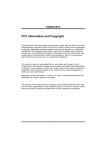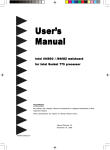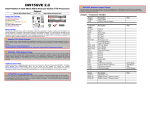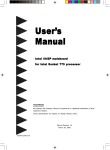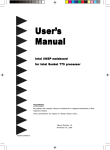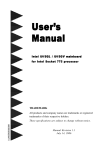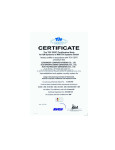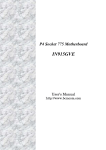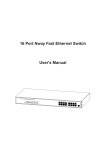Download Quick User's Guide Quick User's Guide
Transcript
Quic Quick User’s Quick k User’ User’ss Guide Guide VIA P4M800 mainboard for Intel Socket 775 processor TRADEMARK All products and company names are trademarks or registered trademarks of their respective holders. These specifications are subject to change without notice. Manual Revision 1.0 September 29, 2005 6000002VKM310 English DISCLAIMER OF WARRANTIES: THERE ARE NO WARRANTIES WHICH EXTEND BEYOND THE DESCRIPTION ON THE FACE OF THE MANUFACTURER LIMITED WARRANTY. THE MANUFACTURER EXPRESSLY EXCLUDES ALL OTHER WARRANTIES, EXPRESS OR IMPLIED, REGARDING ITS PRODUCTS; INCLUDING ANY IMPLIED WARRANTIES OF MERCHANTABILITY, FITNESS FOR A PARTICULAR PURPOSE OR NONINFRINGEMENT. THIS DISCLAIMER OF WARRANTIES SHALL APPLY TO THE EXTENT ALLOWED UNDER LOCAL LAWS IN THE COUNTRY PURCHASED IN WHICH LOCAL LAWS DO NOT ALLOW OR LIMIT THE EXCLUSION OF THE IMPLIED WARRANTIES. 2 1. Specification Processor Support ® ® ® ® English Socket LGA775 for Intel Celeron D 3xx series, Intel Pentium 4 5xx/6xx series up to 3.4GHz ® Support Intel Pentium with Dual core processor up to 2.8GHz Support 533/800 MHz front-side bus Chipset VIA P4M800ce + 8237R Plus AGPset with VIA Unichrome Pro Graphics core Main Memory Two 184-pin DDR SDRAM DIMM sockets Support single-sided or double-sided 2.5v DDR-266/333/400 DIMMs in 64/128/256/ 512Mb/1Gb technologies Support up to 2GB memory size Expansion Slots Three PCI connectors compliant with PCI v2.2 One 1.5v AGP-8X connector compliant with AGP v3.0 One CNR (Communication & Networking Riser) slot for V.92 analog Modem in Secondary mode I DE Two IDE interfaces (up to 4 IDE devices) with UDMA-33, ATA-66/100/133 support from chipset IDE controller USB Eight USB connectors compliant with USB2.0 from embedded USB controller (4 connectors at rear panel) S-ATA Two S-ATA ports with up to 150MB/s bandwidth with RAID 0, 1, JBOD support LAN Integrates 10/100Mps Fast Ethernet controller with onboard VIA 6103L PHY LAN I/O Fintek LPC IO controller with PS/2 keyboard&mouse, floppy, printer, serial and CIR/SIR interface Support Hardware Monitoring function Intelligent fan speed control for CPU-fan (PWM) for quiet operation 3 Audio Onboard Realtek ALC-655 selectable 2 or 6-CH audio CODEC - AC’97 v2.3 compliant English - Supports CD-In, Aux-In - Supports automatic “jack-sensing” - Rear panel audio jacks configuration: Audio Jack Color 2 ch an n el 6 ch an n el Light Blue Line-in Rear stereo-out Lime Line-out Front stereo-out Pink Mic-in Center&Subwoofer BIOS Flash EEPROM with Award Plug & Play BIOS Support ACPI S3 (Suspend To RAM) mode in ACPI compliant O/S Support EZ Boot for fast bootable device selection Support Magic Health for system hardware status report during system boot-up Special Features Support KBPO function – Keyboard power on, turn on the computer from keyboard Support Wake-On-LAN by PME Support USB resume in S3 PowerBIOS for excellent overclocking features: - Programmable FSB Clock output frequency with 1MHz fine tuning - Support BIOS adjustable CPU multiplier, FSB clock settings Form Factor 245mm x 230 mm Micro-ATX size Supported O/S Windows 98SE/ Windows 2000/Windows XP 4 English 1.2 Block Diagram 5 2. Setting up the mainboard Before assembling the mainboard into the PC case we recommend you to do the following: 1. CPU Installation English 2. DDR Memory Insertion After the mainboard is fitted into the case, you may 3. Install Add-on VGA or PCI cards (Optional) 4. Connect the internal cables and wires 5. Connect your external peripherals to the rear I/O port 3. Installation 3.1 CPU Installation 1 2 Step 1 Step 2 Open load plate ( A ) , DO NOT touch socket contacts ( B ). Remove protective cover ( C ) from load plate. Please do not discard the protective cover. Always replace the protective cover if the processor is removed from the socket. 6 4 English 3 Step 3 Step 4 Remove the processor from the protective cover. Do not touch the bottom of the processor. The processor cover should not be discarded. Always replace the processor cover if the processor is removed from the socket. Hold the processor with thumb and index fingers as shown. Ensure fingers align to the socket cutouts ( D ) , processor notches ( E ) align to socket convexes ( F ). Place the processor straight down without tilting or sliding in the socket. The CPU is keyed to prevent incorrect insertion, do not force the CPU into the socket. If it does not go in easily, check for mis-orientation. 5 Step 5 Fan Clips Place the fan heatsink onto the mainboard with the fasteners align to the holes. Be care not to damage the thermal interface material attached to the bottom of the heatsink. Rotate the clips 90 degrees to lock the CPU cooler in place. Connect the fan cable to the mainboard header JCPU_FAN. 7 3.2 DDR Memory Insertion The mainboard accommodates two PC2100/PC2700/PC3200 184-pin DIMMs (Dual In-line Memory Modules): English • Supports up to 2.0GB of 266/333/400MHz DDR SDRAM. • Supports unbuffered non-ECC DIMMs. • DDR SDRAM supports 64, 128, 256, 512MB and 1GB DIMM modules. • Supports DRAM configurations defined in the JEDEC DDR DIMM specification. To install, align the notch on the DIMM module with the connector. Press straight down as shown in the figure until the white clips close and the module fits tightly into the DIMM socket. Notch 3.3 VGA and PCI card installation This mainboard is equipped with on-chip graphics engine, you may connect a VGA monitor directly to its rear port. However, if you need to install VGA card follow the steps below. To install a VGA card into the AGP slot or a PCI expansion card: 1. Remove the bracket (on the PC case) for the slot you intend to use. 2. Firmly press down the card into the slot until it is completely seated. For an AGP card ensure the AGP slot clicker is locked as shown in the picture below. 3. Secure the card's bracket to the PC case with a screw. The AGP slot supports only newer VGA cards with 1.5V specifications. 8 3.4 Rear IO Port PS/2 Mouse Line-in/Rear out (Light blue) Line-out/Front out (Lime) PS/2 Keyboard Mic-in/Center&Subwoofer (Pink) COM VGA USB2.0 ports 3.5 Internal Connectors 1 4 1 2 4 3 6 9 5 11 7 10 8 9 English RJ-45 LAN Parallel Port Connectors 1 Figure Discriptions CPU / Power Fan Power Connectors JCPU_FAN JPWR_FAN English Control Ground Sense +12V JPWR_FAN: Use this connector if you are installing an additional fan in the unit. Ground Sense +12V Floppy Drive Connector 2 FDD 3 IDE1 Primary IDE 1 Primary/Secondary IDE Connector Connects to the IDE device, i.e. HDD and CDROM device. 1 IDE2 Secondary IDE When using two IDE drives on the same connector, one must be set to Master mode and the other to Slave mode. Refer to your disk drive user’s manual for details. 1 10 20 4 PW1 PW12 3 Ground +5V +5V +12V PW-OK Ground +5V Ground Ground Ground +5V PS-ON Ground 3.3V Ground -12V 4 +12V +12V 5VSB 1 2 -5V Ground Ground 3.3V MIC_In 1 2 CFPA Front Line-out-R Rear Line-out-FR Key Rear Line-out-FL Front Line-out-L 9 6 10 CD-IN AUX-IN 1 10 CD_IN_Right AUX_IN_Right CD_Reference GND CD_IN_Left 1 PW12: 4-pin ATX12V Power Connector The plugs of the power cables are designed to fit in only one orientation. The PW1 and PW12 Power Connector must be used simultaneously. CFPA: Front Panel Audio Connector GND +5V NC PW1: 20-pin ATX Power Connector 3.3V 1 11 5 JCPU_FAN: Connect the CPU fan to this connector. AUX_IN_Left This connector is used only if the speaker and microphone needs to be plugged at the front of the PC case. Otherwise, leave the jumpers at the default position. CD-IN/AUX-IN: CD Audio-in connectors These connectors are used to receive audio from a CD-ROM drive, TV tuner or MPEG card. Connectors Figure Discriptions CUSB3/CUSB4: Four USB2.0 header This mainboard includes 4 additional onboard USB ports. CUSB3 CUSB4 To use these additional USB ports, a USB bracket is required. Please contact your retailer for details. CFP: Case Front Panel Connector 8 9 CFP HD_LED This LED indicates hard drive activity. PWR_LED Connects to the power indicator on the PC case. RST Connects to the RESET switch on the PC case. PW_ON Connects to the Power button on the PC case, to turn on the system. To turn off the system, press the power button for 4 seconds. CIR CIR: IR connector For connection to an IrDA receiver unit. CSPK CSPK: Speaker Connects to the case’s speaker for PC beeps. SATA1 SATA2 1 GND B+ BA- A+ GND GND 10 JCMOS 1 Settings: 1-2: Normal (Default) 2-3: Clear CMOS 11 JUSB 1 Settings: 1-2: Connect (S3 enabled) 2-3: Disconnect (No S3) SATA1 / SATA2: Two Serial ATA Connectors These connectors enable you to connect Serial ATA HDDs or optical drives type. JCMOS: Clear CMOS data Jumper This resets the BIOS CMOS data back to the factory default values. Recommend to leave at Normal (default) postion. JUSB: USB S3 Wake up Jumper This jumper disconnects 5V standby voltage to USB devices. This means USB devices will not be able to wake-up the system from S3 (Suspend to RAM) power saving mode. 11 English 7 4. BIOS BIOS Setup English When you start up the computer for the first time you need to enter the BIOS CMOS Setup Utility. Power on the computer and press <Del> key during POST (Power On Self Test). The BIOS CMOS SETUP UTILITY opens as shown below: < CMOS Setup Utility> Select and enter "Load Optimized Defaults" page. This page loads the factory settings for optimal system performance. Follow the simple on-screen instructions to complete this procedure. Press "ESC" to exit and select "Save & Exit Setup" to continue to boot. For more information regarding BIOS settings refer to the complete manual in the bundled CD. 12 5. Driver Installation English Once the operating system has been installed, you need to install the drivers for the mainboard. Please select Method 1 Auto Installation Method 2 Manual Installation >>VIA SERVICE PACK 4_IN_1 Driver >>AC’97 AUDIO Driver >>VIA LAN Driver >>VGA Driver >>USB 2.0 Driver >>VIA SATA RAID Driver Insert the bundled CD into the CD-ROM and the main menu screen will appear. The main menu displays links to the supported drivers, utilities and software. Method 1 This item installs all drivers automatically. Method 2 This item allows you to install the drivers selectively. Step 1 : Click “VIA SERIES 4_IN_1 Driver” to install chipset driver. Step 2 : Click “AC’97 AUDIO Driver” to install audio driver. Step 3 : Click “VIA LAN Driver” to install LAN driver. Step 4 : Click “VGA Driver” to install onboard graphics driver. Step 5 : Click “USB V2.0 Driver” to install USB 2.0 driver. Step 6 : Click “VIA SATA RAID Driver” to install Serial ATA driver. 13 6. Flashing the BIOS Do NOT flash the system BIOS unless it is really necessary. Updating and flashing the BIOS content risks BIOS data corruption which may cause system unable to power-on. English Download the xxxxx.EXE file corresponding to your model from our website to an empty directory on your hard disk or floppy. Run the downloaded xxxxx.EXE file and it will self extract. Copy these extracted files to a bootable floppy disk. Note: The floppy disk should contain NO device drivers or other programs. 1. Type “A:\AWDFLASH and press <Enter> Key. 2. You will see the following setup screen. 3. Please key in the xxxxx.bin BIOS file name. 4. If you want to save the previous BIOS data to the diskette, please key in [Y], otherwise please key in [N]. XXXX XXXX XXXXX xxxxx.bin 5. Key in File Name to save previous BIOS to file. XXXX XXXX XXXXX xxxxx.bin xxxxx.bin xxxxx.bin XXXX XXXXX xxxxx.bin 14 XXXXX xxxxx.bin 7. The BIOS update is finished. F1 : Reset 6. To confirm and proceed, please key in [Y] to start the programming. F10 : Exit 8. Keep this BIOS floppy disk for future use.















